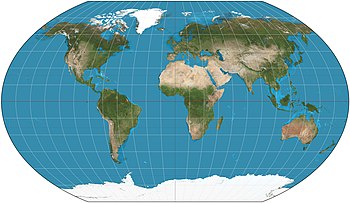Kavrayskiy VII projection


The Kavrayskiy VII projection is a map projection invented by Soviet cartographer Vladimir V. Kavrayskiy in 1939[1] for use as a general-purpose pseudocylindrical projection. Like the Robinson projection, it is a compromise intended to produce good-quality maps with low distortion overall. It scores well in that respect compared to other popular projections, such as the Winkel tripel,[2][3] despite straight, evenly spaced parallels and a simple formulation. Regardless, it has not been widely used outside the former Soviet Union.[3]
The projection is defined as
where is the longitude, and is the latitude in radians.
See also[edit]
References[edit]
- ^ Snyder, John P. (1993). Flattening the Earth: Two Thousand Years of Map Projections. Chicago: University of Chicago Press. p. 202. ISBN 0-226-76747-7. Retrieved 2014-11-05.
- ^ Goldberg, David M.; Gott III, J. Richard (2007). "Flexion and Skewness in Map Projections of the Earth" (PDF). Cartographica. 42 (4): 297–318. arXiv:astro-ph/0608501. doi:10.3138/carto.42.4.297. S2CID 11359702. Retrieved 2014-11-05.
- ^ a b Capek, Richard (2001). "Which is the best projection for the world map?". Proceedings of the 20th International Cartographic Conference. 5. Beijing, China: 3084–93. Retrieved 2014-11-05.
External links[edit]
Wikimedia Commons has media related to Maps with Kavrayskiy VII projection.
- Curvature in Map Projections, quantification of overall distortion in projections.
- Mapthematics Kavrayskiy VII, bivariate distortion map.
- Deducing the Kavrayskiy VII Projection, description of the properties of the Kavrayskiy VII projection.


 French
French Deutsch
Deutsch

